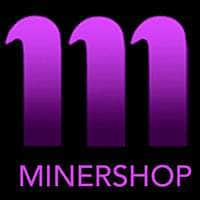Howie and His White Whale - An Old Greenland Trip Report
MY SUMMER VACATION (2002 - IT BEGINS)
(BY HOWARD GREEN 08/28/02)
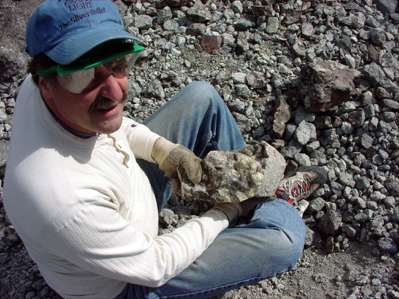
Being 49 years old and growing up in the Franklin area, I have certainly experienced efficient fluorescent collecting. But growing tired of the current predominance of "silver-pick" collecting, I decided to plan an adventure. My twenty-year old son, Danny, "owes" me two days of muscle annually, but I was pleasantly surprised when he "couldn't pass up a collecting trip to Greenland, especially via Copenhagen, where they sell beer in the soda machines."
We set up our trip with the guidance of Mark Cole of Minershop.com. We left NY JFK on August 1, bound for Copenhagen, spent a few days there, and continued via an Air Greenland 757 bound for Narsarsuaq Airport in southern Greenland. In addition to the usual knapsacks, hammer and chisels, disposable cameras, and our trusty Superbright (allowed as carry-on with an identifying brochure) with battery pack and the new Europlug adapter, we had to make sure to be prepared for local conditions. The forecast was for temperatures in the high forties and potentially severe winds, twenty hours of bright sunlight, swarms of Arctic mosquitoes resembling "small birds with fur", and erratic food supplies. Thus we brought multiple layers of clothing, hiking boots and windbreakers, mosquito-net hats and 95% DEET, and plenty of food. We also brought an opaque black plastic barbecue grill cover to use as a portable tent for daylight UV viewing. Plans began to unravel when fog over southern Greenland prevented landing and we were forced to travel to Kangerlussuaq Airport at an abandoned US Air force base above the Arctic Circle. The airline put us up at a "conference center", but we were soothed by dinner at an actual first-class European-style restaurant, where Danny had reindeer and I had salmon and halibut for dinner (and of course Tuborg and Carlsburg).

We were able to fly out and land the next day but as our ferry connection was missed, our guide Peter picked us up in his six-passenger motorboat for the one hour trip to his home and our home base for the next week, Narsaq. Despite predictions, we experienced a heat wave with daily temperatures in the seventies, no wind, no fog, no rain, and very demure mosquitoes.
Narsaq is a population 2000 shore town fully stocked with computers and DVD players, cell phones, modern supermarkets, a hospital and a heliport. The fjords are a deep blue color, the icebergs bright bluish white, the sky bright blue, the town grassy, and all the one or two story buildings very brightly painted colors. We found the people in general and our guide Peter, his family and friends particularly hospitable. Their English is much better than our Danish ( I knew that salmon is "laks", and Danny knew that timetable is "fartplan") or Greenlandic, and more than adequate for all purposes except knowing the English names of the various fish we ate.
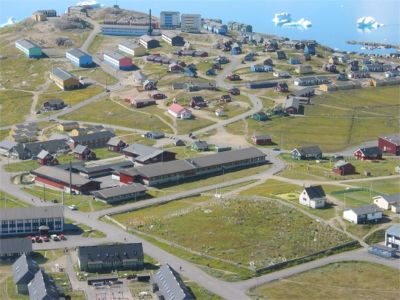
Transportation to neighboring towns is by boat. The only road out of town leads to nowhere but the famous Illimaussaq mineral complex.
The March 1993 issue of the Mineralological Record offers the definitive geologic description of the Illimaussaq district. Technically great similarities exist between Illimaussaq minerals and those of the Kola Peninsula in Russia, and of Mt St Hillaire and the Kipawa complex in Quebec. In brief, Illimaussaq is a semicircular area on two separate islands separated by the Tunuliarfik Fjord, and is near where Eric the Red settled over a millenium ago. The mountain Illimaussaq is at the head of a valley several miles northeast of Narsaq. Arising on either side of the valley is the Tarsaq slope to the east and the famous Kvanefjeld peak on the west. On the shore of the fjord northeast of Narsaq is the original tugtupite site type locality. On the island east of Narsaq is another collecting site at the head of the Kangerluarsuk fjord. We would travel by boat or truck as far as possible and then hike up the mountains. Beautifully scenic mountains with snowy tops, separated by cold mountain streams with waterfalls and actual green vegetation belied the difficulty of the climbs, the actual soil being quite friable. Hikes uphill would take one or two hours, and downhill laden with rocks took just as long. With moderate caution, at no time was there any danger.

Upon arrival our first night we immediately went up the Tasaq slope for night UV collecting, waiting until 11 PM for darkness. There was enough light for accurate footing during our 2 AM descent. We found abundant quantities of massive yellow translucent sodalite fluorescing brilliant orange LW, less brilliant SW, intermingled with a bright green SW fluorescing mineral, possibly berylite. The sodalite fluorecsence is dramatically brighter and more beautiful than any Canadian, Russian, or Afganistan hackmanite or sodalite that I've seen, and is massive in basketball-sized boulders. There was plenty of tugtupite, white or pink rather than gemmy red in natural light but with the beautiful characteristic fluorescence of red SW and orange LW. This was the original site for the discovery of eudialyte, and there was plenty with large aerigine crystals, but the dull opaqueness of the eudialyte makes it inferior to the gemmy specimens from Kola and Quebec. We also found nonfluorescing analcime crystal arrays, with opaque but well-formed white golf ball sized crystal clusters. Mark's website, www.minershop.com has great photos in both natural and UV light.
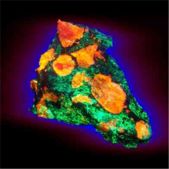
The next day we toured the capital of South Greenland, Qaqortoq, which was an hour boat ride from Narsaq. We then sailed past icebergs and seals to the head of the Kangerluarsuk Fjord, where we made our greatest finds of sodalite. The sodalite is either gemmy green or magenta, massive, and constituting the entire bulk of basketball-sized boulders. It is tenebrescent, turning magenta upon exposure to SW UV and staying that color until exposed to bright white light, which turns it back to its original color. This transformation doesn't extinguish, or effect the fluorescent properties. Other intermingled fluorescents were albite F SW magenta, and green and blue unknowns.
Peter's son, Ulrik, and Danny then informed us that the next day's activity would be fishing instead of rock collecting. Thus, we spent the morning catching sea trout from the shore of a cove in the fjord, very similar to fly fishing in a river. These trout are actually what we call Arctic char here. Peter's wife Judithe cooked our fish after the boys gutted them. My contribution was cooking the great Greenlandic delicacy kasha varnishkes, which we had brought with us.

Wednesday we made the most difficult climb to historic Kvanefjeld. The nearly vertical climb was almost too hard for me physically, and in my opinion impossible without an experienced guide. Gemmy tugtupite, (the Greenlandic name is tuktu, a name deriving from the word "tuttu" - meaning reindeer blood) was the goal here, but only achieved by picking someone else's tailings or being a local expert. Peter is such an expert, his main profession being cutting tugtupite in cabs and setting it into beautiful necklaces and bracelets (I didn't see any tugtupite Western string ties, thank goodness). His method for finding tugtupite is to find a white vein in the traprock, drill into the vein, and if red smoke emerges, develop that vein. Needless to say this was beyond the scope of our collecting. We found adequate tugtupite with minor sorensenite. I did manage to pick up a fist-sized piece of solid gemmy Kvanefjeld tugtupite from the local town mineral shop owner, Borge, who spoke no English, for an incredible $7. I also picked up a nice cryolite/siderite/galena specimen from him for the same price. The type locality for this is Ivigut, on Greenland's southeast coast. He fooled me though (language barrier, not deceit) when I pointed to the willemite of the Mineralologic Record species list and he sold me villiaumite (not fluorescent and not comparable to that from Kola).

Thursday's boat trip was along the fjord and required the seafaring expertise of Peter's friend, Harry. Harry is a 75 year-old Norwegian who is an indescribably colorful character. Our first stop was close to town, up a steep and friable cliff where we found green and red sodalite, and associated ussingite. The altitude where the ussingite is found is almost inaccessible. Ussingite is a beautiful translucent lilac color, but doesn't fluoresce like that from Kola, which fluoresces green SW. Incidentally, the red sodalite is a stable natural color and not the result of a photochromic transformation, even though it is the same color as green sodalite turned red by SW UV. We next visited the original historic site of the first tugtupite find. It is right on the shore but at a tricky landing, so Peter and I collected while Harry and Danny stayed on the boat. When Harry went after a seal, Danny diverted him from his goal by asking to be taught how to shoot the rifle. Danny avoided aiming at the seal, merely attempting to avenge the Titanic by aiming at icebergs. This collecting site was the most fascinating of all for me. The rock is solid fibrous white intermixed with solid, harder clear material. I gathered too little, not being guided by my UV light, which was left on the now "seal-hunting" boat. The LW fluorescence was standard sodalite bright orange, but the SW was a pinkish-peach color unfamiliar to me and the most pleasant I've experienced. The natural light appearance of this material is most reminiscent of tugtupite, and perhaps sodalite and tugtupite should be thought of as a series. This material is now being analyzed for identification by Josef Vajdek of Pequa Minerals.
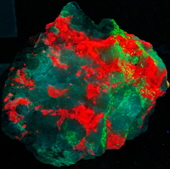
Friday was a wild-card day, and I chose to go back to the Tasaq slope in pursuit to tugtupite. We located our quarry easily, but much hard work was needed to collect our fill. The quality of the specimens is excellent under UV but bland in natural light.
By Saturday we were packed and aboard a 25 seat helicopter to return to Narsarsuaq airport. We were able to meet Mark Cole, who was arriving that day, and share the enthusiasm of our trip. We arrived back in New York via Copenhagen by Sunday night, still excited and surprisingly fresh. It was in every detail the most amazing experience. One minor regret was not taking full advantage of the heat wave and doing more night collecting, especially at Kvanefjeld. Overall the opportunity to take this adventurous trip with my son was the most special aspect of all.
GREENLAND 2.0
(2003) THUS BEGAN "THE QUEST FOR WHITE WHALE"
A SEQUEL TO MY SUMMER VACATION
(INITIALLY PUBLISHED IN THE UVWAVES - MINOR EDITS AND PICTURES BY WEBMASTER)
After a terrific rock-collecting adventure at the famous Ilimaussaq Complex in Greenland in 2002, the last thing on my mind was a return trip. Nevertheless, as I talked about my experiences with friends and fellow collectors, and compared notes with the few others who had made the trip, my attitude began to change. Although my haul of rocks was amazing, the urge to pursue "the one's that got away" began to resemble Ahab's obsession with the white whale.

I resolved to return and began to plot a strategy designed to make collecting more efficient. Of course I knew the sites and minerals to target. I was sated on sodalite, but needed to improve my collection of tugtupite, chkalovite, and ussingite. I especially craved a return to the site of my find of a unique and highly prized soda/tug mix characterized by spectacular fluorescent and phosphorescent properties. Technical improvements would be necessary though. I needed better tools. An adequate backpack was a start. The kid at the camping store outfitted me with a strong but lightweight model, which distributed loads evenly over upper back, pelvis and shoulders. When he cautioned me not to carry over 80 lbs, I assured him that the back, not the pack, was the limiting factor. A longer handled crush hammer and a 20 lb. sledge were important improvements, but my Superbright lamp and Weber grill cover/portable-viewing tent were unsurpassable. My main innovation, however, was in bringing Mark Cole and Herb Yeates for their technical and mineralogical knowledge. Their ability to self-propel without special power sources (beyond hot dogs and PB&J sandwiches) was an additional advantage.
Travel was much easier this year, flights through Iceland rather than Copenhagen being available. I met Mark and Herb at Keflavik, Iceland's International airport. We became well acquainted during the seven-hour holdover at Reykavik, Iceland's boondock airport. The flight to Narsarsuaq, South Greenland's airport, was exciting and scenic, with incredible vistas of the icepack and glaciers spilling into fjords. It was wonderful to reacquaint with our local guide, Peter.
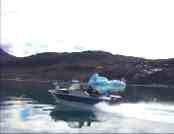
He transported us by motorboat to our home base, Narsaq, a modern town of 1700 inhabitants. Observing that no life jackets were available led me to two related deductions. First, the fjord is so cold as to be unendurable even with life jackets. In addition, the Greenlandic people have nowhere to learn how to swim.
Much thought was given to gifts for Peter and his family. Mark chose a bottle of Jack Daniels, while I opted for two pounds each of cherries, plums and peaches. The gifts were gone immediately, the fruit being devoured and Mark claiming to have left the bourbon on the plane.
The Ilimaussaq complex has several main collecting sites. Taseq and Kvanefjeld are mountains on either side of a valley north of Narsaq. Kangerluarssuk and the Agtakorfia are on the shore of fjords, and are accessible by boat.
Collecting began an hour after arrival, with the Taseq slopes as the destination. Elation and disappointment resulted right away. I found major tugtupite in chkalovite "eyes", and the most massive and brightest sorensenite I've encountered. Chkalovite fluoresces greenish-white, and surrounds blood-red fluorescing tugtupite. Sorensenite is usually in the form of blades fluorescing beige. Unfortunately our strategy of rapid-movement UV-guided night collecting was thwarted by the absence of adequate darkness, it being early July. Herb was temporarily disappointed at the inefficiency of his first Greenland collecting experience, while I was amazed at how my skills had improved with a winter of conscious and subconscious rehearsal.

A year of anticipation led to the following morning's trip to the historic Tugtup Agtakorfia, along the Tunulliarfik fjord (named after the first European settler, Eric the Red, Leif's father). I was able to find the tug/soda mix site, and we collected almost all there was. This material is white in natural light, and fluoresces intensely peach SW, white MW, and orange LW. It also has very long and bright white phosphorescence. We then proceeded up the side of a steep cliff where gem quality, lilac ussingite, associated tugtupite, and gray and green sodalite are abundant. I was frustrated to realize that my day's cache consisted of predominantly aquarium gravel, a fact that Herb delights in reminding me. When Mark and Herb left the next day for an overnight camping trip to a site at the Kangerluarssuk fjord where I had collected well the previous year, I snuck back to Tunulliarfik with Peter.

Peter's wife, Judithe, and her friend Eva, a Danish nurse spending the summer working in Narsaq's hospital, accompanied us. The ladies spent the day searching for plants, especially a particularly bitter form of Greenlandic rhubarb. My decision (obsession) with returning was rewarded with my best day of rock collecting ever, enabling me to tolerate the eternal aquarium gravel jibes. I returned with boulder-sized tugtupite, chkalovite, ussingite and intensely tenebrescent sodalite combos. The tug was white in natural light, but deeply blood red SW and salmon LW. My best finds were 2-3" wide, 6" long strips going straight through the boulder and emerging on the other side outlined by green fluorescing chkalovite. After SW and even LW exposure, the incredibly tenebrescent gray sodalite (hackmanite) remains deep grape purple in sunlight for many minutes. The most aesthetically pleasing and intensely tenebrescent hackmanite was a two inch wide gray vein outlined by non-tenebrescent white matrix rock. Fortunately the ladies' light vegetable load enabled them to help me transport my load down the slope to the boat. The rest of the evening was spent with Peter's family for dinner and in marveling at my new mineral finds. I skipped the rhubarb.
The next day Peter dropped me off at the same site for solo collecting while he continued on to the airport to pick up our two new colleagues, Kathy and John. Mark and Herb used this time to sleep off their overnight. I suspect that Herb kept sneaking into my room to gaze at my haul, thus fueling his own obsession for 2004. Meanwhile, I collected more of the same although less abundantly. My prize for the day was a basketball-sized mix of three inch in diameter eyes of tug embedded in chkalovite all embedded is tenebrescnt orange fluorescing sodalite studded with green fluorescing ussingite and yellow fluorescing polylithionite. This huge five color boulder is regarded as the current "king" of Ilimaussaq in America. A funny thing occurred while I was alone along the shore with my back turned to the fjord. Of course it's absolutely quiet in this remote place, but an iceberg snuck up behind me and chose that moment to break apart. The sound was thunderous, and I wish that I could've harnessed the vibrational energy of my spontaneous leap for use in future climbs. The iceberg remnant rolled in the fjord for several minutes mimicking playful polar bears until it reached its new floating equilibrium. The fjord water is salty, but the inland streams of newly melted glacier water yield ice cold and surprisingly tasty hard water. Herb thinks it's the beryllium dissolved therein. Giardia, a sheep-hosted parasite, is a theoretical problem. (Local industry consists of sheep farming and shrimp processing. Surprisingly inept arctic mosquitoes constitute the remainder of the land fauna. We honorary Norsemen offer condolences to all Arizona fluorescent collectors, but there are no fluorescent scorpions or lizards or snakes here.)
Mark, Herb and I were staying at a bicycle shop turned motel while John and Kathy had accommodations at a bed and breakfast run by "the old lady" (her actual name, I believe.) Narsaq's modern stores supplied all our needs, while a bakery and a hot dog stand supplied all our wants. A local rock store and mineral museum is a favorite stop for us in no small part because of the graciousness of its owner, Borge. I enjoyed becoming reacquainted with the local "characters", especially ageless Harry, a Norwegian plumber/ fisherman/hunter/motorcycler/raconteur. I also arranged with the medical staff at the Narsaq Hospital to lead a seminar discussing Seasonal Affective Disorder (winter depression) and bright light treatment. (The IRS has yet to offer an opinion on some of my expense receipts.) The overwhelming impression given by the Greenlandic people is of fierce pride in their way of life and in their land, but also in the cultural and religious influences of a millennium of European input.
As on my previous trip, the weather was generally excellent and we lost collecting time only to the lack of darkness, not inclement weather. Temperatures were consistently in the 60s, although cooler before sunrise. Climate is a serious variable, as summer fog can prevent air travel, and as the "fohn" brings winds up to 100 mph. The Ilimaussaq segment of the Canadian collecting expedition of 2001 was basically was "winded out" by the fohn. Apparently Mark's Miami phenotype has modified his New England genotype, leading to his discovery that turning on all the stove burners was not an efficient way to heat our motel. The fuses held out for only a few minutes, much like at Sing-Sing on execution days.

The famous Kvanefjeld site was the destination the next day. This begins with a 5 km. drive on the only road out of Narsaq, through the valley between Taseq on the southeast and Kvanefjeld on the northwest, and straight towards Ilimausaq, the majestic glacier-topped peak that gives the region its name. Sheep, sheepdogs and wild ponies share the road, completing the trip's best photo op. A 1 km. walk up a road impassable even to 4-wheel drive vehicles leads to an abandoned uranium mine and is followed by a nearly vertical climb to the peak. John and Kathy were particularly interested in the uranium mine and tailings, but for me it's fluorescents only. A plateau atop Kvanefjeld is the main collecting site. The local's quest is dark red tugtupite, which is then cut en cab for jewelry. White albite veins are drilled and if any pink smoke is seen, that vein is developed. The matrix syenite is so hard that the developmental method is TNT. Apparently an attempt previous to our arrival was a bit too ambitious because Peter looked expectantly for tug blown clear across the lake opposite the blasting site. My strategy was to look for white albite bordering on blasted syenite, deducing that this would be ignored in the search for gemmy tug. I did quite well with this approach, finding abundant white tug. Nice chkalovite eyes were also prevalent. This Kvanefjeld tug is the most spectacularly fluorescent, the familiar blood red color highlighted by pale green fluorescing chkalovite and bright green fluorescing beryllite. Tugtupite offset with brightly fluorescing sorensenite needles is rare, as is the gemmy red tug itself.

The collecting site in the complex with the greatest diversity of minerals is the Taseq slope. The approach is by truck, then by foot across a bridge spanning a shallow stream. Walking through fairly dense bushes leads to a moderate climb up the slope for collecting, the trek taking about ninety minutes. We were able to drive fairly close to the vertical slope but couldn't cross the stream due to the freezing water temperature. I was the guinea pig, but in the time it took for me to put my second foot in the water, my first foot was achingly and unbearably frozen. On this trip we did manage a shortcut farther downstream by traversing a fairly treacherous path of rocks in the stream. On the way back Herb decided to run an experiment on the human tolerance for immersion in freezing water, and found that his clothing protected him for a brief period of time longer than my bare feet were able to stand. Fortunately for me, my feet dried much more quickly than his clothes. Not surprisingly, his second trial of this experiment later in the week yielded a similar result. Although I haven't checked, I'm sure the data can be found on his website. We did very well with abundant yellow soda and with white and some red tug, all fluorescing as usual. Nice surprises were blue-white fluorescing analcime, incredible silver polylithionite, and some green, violet and lilac fluorescing unknowns. I also found a nice amount of extremely bright chkalovite, and "fire-tug" so brightly fluorescent that the visible red light emitted is sufficient to illuminate one's entire hand.
 Mark and Herb did very well at a vein of tugtupite admixed with analcime and a uranyl-activated green fluorescing unknown, constituting extremely beautiful and large specimens. Non-fluorescent species found here include eudialite, najaukasite, epistolite, and aegerine. As most readers already know, spectacular pix of all of these minerals are available at Mark's website, www.minershop.com. We developed an interesting superstition during this trip. To desist from the tendency to stuff one's pockets without UV guidance on the way down the mountain, we made a rule that if any daily yield was insignificant, the practice would end. The practice persists!
Mark and Herb did very well at a vein of tugtupite admixed with analcime and a uranyl-activated green fluorescing unknown, constituting extremely beautiful and large specimens. Non-fluorescent species found here include eudialite, najaukasite, epistolite, and aegerine. As most readers already know, spectacular pix of all of these minerals are available at Mark's website, www.minershop.com. We developed an interesting superstition during this trip. To desist from the tendency to stuff one's pockets without UV guidance on the way down the mountain, we made a rule that if any daily yield was insignificant, the practice would end. The practice persists!Protecting each specimen in bubble wrap for the trip back to America was tedious but worth the work. I felt jealous at leaving the others behind but enthusiastic about their finds during the remainder of their stay. As parting gifts, I bought a huge tub of jelly and genuine Jif chunky for Mark and Herb, and gave Peter some rich Sterling Hill "green and red" that I'd brought along. Little did I know my most suspenseful and adventurous time was about to begin. I was scheduled for a stop overnight in Reykavik, and then for an hour drive to Keflavik International en route to JFK. Well, the plane originating in the Faroe Islands got to Greenland a day late, promising to get me to Iceland right on time, but to the wrong airport. With no flights the following day, my return would be several days behind schedule. As luck would have it, when landing in Iceland, I was overjoyed to see that we were at Keflavik. Apparently they don't move customs to Reykavik for just one arrival. A half-mile run (go, OJ, go) to transfer rocks from incoming to outgoing, and I was on IcelandAir for JFK. My wife was pleasantly surprised to get my call, as I hadn't had the time to reach her to reinstate the cancelled original schedule.
This winter has been a continual joy; sorting, cataloguing, comparing, bragging, but mostly sharing new wonders and old stories. Nice experiences have been a talk about the entire experience given at Ultraviolation 2003, and a discussion of the tenebrescence of hackmanite at the FMS northeast regional meeting. We compared samples of hackmanite from Greenland, Afganistan, the Kola Peninsula, Mont Saint-Hilaire and Bancroft. My winter highlight was a get together in Florida with Mark and his daughters, Herb and his wife, my wife, plenty of pizza, and plenty of rocks.
This trip and this experience have been so invigorating for me that I plan to return in 2004. Mark and Herb will return too, and I hope we'll get a nice additional contingent. Franklin collectors can put down their silver picks and grab their backpacks! The availability, abundance, and quality of the minerals make this the fluorescent collector's paradise.
(Webmaster's note: Howie's quest for that "white whale" continued until 2010 - our last visit. He accompanied me on every tour and we became dear friends. Thanks for the great friendship Howie! Did he ever find the whale? Of course not, that's why he's still having a blast hunting.)

